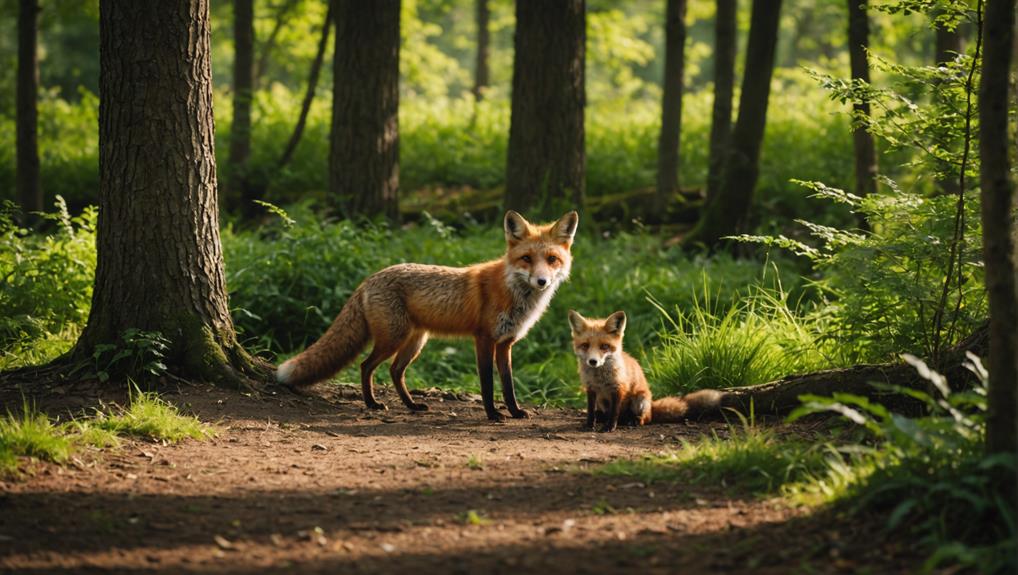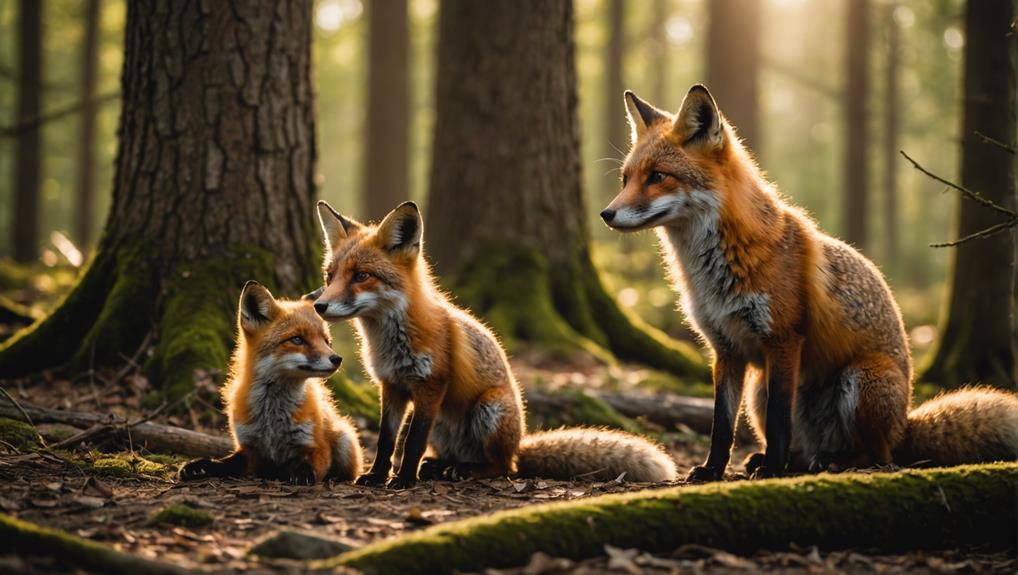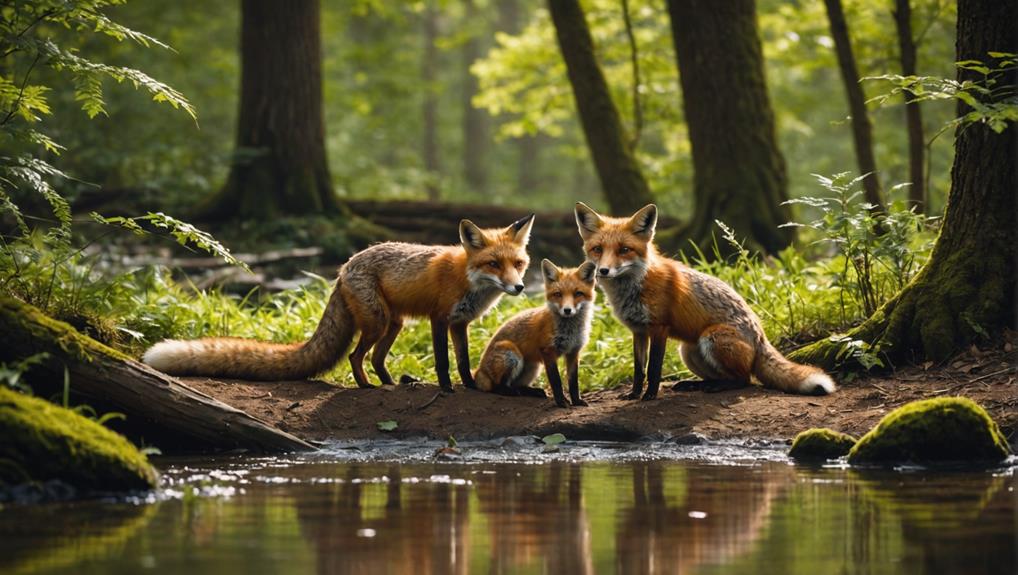Fox family dynamics are really interesting, showing a blend of teamwork, competition, and communication. The dominant breeding pair takes center stage, managing resources and territory, while both parents play active roles in caring for their cubs. The female does about 56% of the food deliveries, but the male helps out too, bringing in around 40%. Communication is key, with vocalizations and body language helping them resolve conflicts and reinforce bonds. You might even say they have a unique family calendar, adapting their parenting as seasons change. Stick around, and you'll discover even more about these clever critters!
Contents
Social Hierarchy of Foxes
Fox families showcase a captivating social hierarchy that revolves around a breeding pair and their offspring. In these family groups, the breeding pair holds the highest social status, managing the territory and making sure everyone has what they need. Subordinate males often display submissive behaviors to keep the peace and maintain access to resources, which can be a tricky balance.
Notably, the dynamics of fox family life can vary markedly across species, as seen in habitat diversity that influences their social structures.
You'd be surprised to learn that even cubs as young as three weeks old can engage in aggressive competition. This fierce rivalry can lead to a mortality rate of around 20% among cubs, all for the sake of food availability! Grooming and play fighting are key ways these foxes reinforce their bonds, helping to ease tensions and keep the family connected.
However, as environmental conditions shift or during the breeding season, the dynamics can change rapidly. Territorial disputes may arise, and roles within the social hierarchy can be reassigned.
While it might seem serious, there's a playful side to these interactions. Watching them navigate their social structure can be as entertaining as it's enlightening, showcasing the complexities of family life in the wild.
Mating Behaviors and Pair Bonds
When it comes to red foxes, courtship rituals can be quite the spectacle!
During the breeding season, males pull out all the stops, competing for the attention of a single vixen, which can feel a bit like a reality show.
But don't be fooled by their seemingly monogamous behavior; genetic studies reveal some surprising twists in their family dynamics, proving that love can be a bit more complicated than it appears!
Courtship Rituals
During the breeding season, courtship rituals among foxes reveal captivating dynamics of mating behaviors and pair bonds. As a female vixen enters her short estrous period, lasting just one to six days, male foxes spring into action.
They engage in competitive behaviors, trying to impress her and secure their chance to mate. Resource availability plays a key role here—when food is scarce, you might see more monogamous mating, but during times of abundance, polygyny can occur, allowing the female to have multiple partners.
While it might seem straightforward, courtship isn't just a walk in the park. Male foxes often guard the receptive vixen fiercely against other suitors. Notably, one-third of urban fox litters show mixed paternity, suggesting that even in the animal kingdom, love can be a bit complicated!
The actual act of copulation involves a unique locking mechanism that protects both mates for a few minutes up to 90 minutes. This strong pair bonding not only guarantees the safety of their union but also demonstrates the lengths these clever creatures go to when it comes to love.
Who knew foxes had such a romantic side?
Breeding Pair Dynamics
In the intricate world of red foxes, strong pair bonds form in early winter, setting the stage for their captivating mating behaviors.
You might find it thought-provoking that the breeding season runs from January to March, with a gestation period of about 51 to 54 days. During this time, the dominant vixen can be quite the social butterfly, attracting attention from several males!
Notably, urban foxes have adapted their breeding behaviors to thrive in city environments, showcasing their remarkable resilience and adaptability in human-dominated areas.
Here are some key points about fox breeding dynamics:
- Vixens are receptive for one to six days, leading to some friendly competition among males.
- Mating includes a copulatory lock that guarantees better chances of fertilization.
- About one-third of fox litters can have multiple fathers—talk about a blended family!
- 70% of urban foxes thrive
- Dominant females often venture outside their social groups to mix things up genetically.
These mating habits reflect a mix of monogamous and polyandrous behaviors, enhancing reproductive success.
While parenting in fox groups is a team effort, those dominant vixens often lead the charge, while subordinate males might find their chances of fatherhood a bit slimmer.
Role of Fox Parents

Fox parents play essential roles in the survival and nurturing of their young. In the fox family dynamics, the breeding pair's parental roles are significant.
The breeding female, often the primary caregiver, contributes about 56% of food deliveries to the den. When the availability of food is high, she spends more time nursing and caring for the pups, ensuring they grow strong and healthy.
Meanwhile, the male fox steps in to provide around 40% of the food, showcasing a wonderful balance of teamwork.
What's fascinating is that male foxes don't just focus on their own pups; they may also assist in caring for others, demonstrating a cooperative breeding dynamic.
This kind of support is important, especially since litters can range between 5 to 8 pups. The survival of these little ones often depends on the food supply. In years with plenty of rodents, you might find larger litters thriving!
You see, while the breeding pair takes the lead, the involvement of additional helpers is minimal.
It's a heartfelt reminder of how dedicated fox parents are to their young and the significance of working together for the sake of their family.
Territorial Behavior and Home Range
Territorial behavior among foxes plays a crucial role in their survival and social structure. It's fascinating how these clever creatures manage their home ranges, often overlapping with family units.
While dominant pairs usually take charge, they've got a flexible approach to territory, rather than strict boundaries. In harsh environments like the Arctic, these dynamics are essential for securing resources and ensuring survival through the seasons, especially when food sources fluctuate due to climate conditions or competition from other predators, highlighting their adaptability in challenging habitats key adaptations for survival.
Here's a little insight into their world:
- Home ranges can be as small as 5 km² in good habitats, but they might expand to 50 km² when resources get scarce.
- Vocalizations and body language help foxes communicate and sort out conflicts over territory.
- Aggressive displays come into play, ensuring that dominant individuals maintain their social hierarchy and access to resources.
- Breeding dynamics hinge on these territorial behaviors, as dominant pairs work hard to protect their patch for successful breeding.
Understanding these dynamics is key to appreciating the parenting roles within fox families. By managing their territory, dominant pairs create a safe environment for their young, ensuring they've the resources they need to thrive.
Communication Within the Family

Understanding a fox family's communication methods reveals the intricate relationships among its members.
These clever creatures use a mix of vocalizations, like "gekking," to express heightened emotions during conflicts. It's fascinating how their body language tells a story too! Dominant individuals stand tall with erect tails and perked ears, while subordinate members lower their heads and ears to show their place in the family hierarchy.
Grooming behaviors are another crucial part of communication. When a fox family engages in grooming, it strengthens their bonds, almost like a furry hug! If grooming stops, it might lead to social isolation—definitely not what we want for our fox friends.
Then there's play fighting among the pups, which helps them practice social skills and understand their roles. It's like a game of tag but with more nipping and jumping!
And let's not forget the significant role of breeding females; they guarantee the pups receive food and care, nurturing communication within the den.
Seasonal Adaptations in Fox Behavior
As the seasons change, fox family dynamics adapt in fascinating ways that reflect their survival strategies. These seasonal adaptations are essential for their breeding dynamics and overall success.
For instance, autumn brings heightened tensions as male cubs reach sexual maturity. This shift can stir things up within family groups, especially among the dominant pairs responsible for breeding.
Here's how these adaptations play out:
- Food delivery rates increase when rodent populations are high, with breeding females contributing considerably—up to 56% of the food!
- Parental investment varies based on seasonal prey availability, showing how important food sources are for nurturing the young.
- Dispersal patterns reveal that pups often leave their natal territory around six months old, but some return to familiar areas, influenced by environmental changes.
- Reproductive success can fluctuate due to climatic conditions, reminding us how closely linked foxes are to their environment.
Understanding these dynamics not only showcases their resilience but also helps us appreciate the delicate balance of nature.
It's a wild world out there, and foxes navigate it with clever adaptations that keep their families thriving!
Final Thoughts
In the wild world of foxes, family life is a fascinating dance of love and teamwork. As they navigate the ups and downs of parenting, each fox plays its part, from nurturing kits to guarding their cozy den. With their clever communication and strong bonds, these furry creatures create a tight-knit family unit that thrives in the great outdoors. So, next time you spot a fox, remember there's a whole lot of heart behind those bushy tails!














